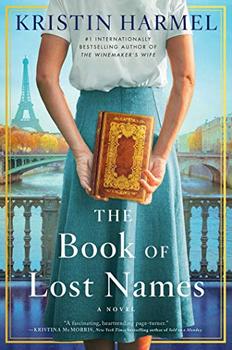Summary | Excerpt | Reading Guide | Discuss | Reviews | Beyond the Book | Read-Alikes | Genres & Themes | Author Bio

This article relates to The Book of Lost Names
 While Eva, the gifted young Jewish forger in Kristin Harmel's The Book of Lost Names, may be a fictional character, the work she did and the risks she took were realities during World War II. Two of the more notable forgers — heroes who saved hundreds of Jewish lives — were Adolfo Kaminsky (1925-) and Alice Cohn (1914-2000).
While Eva, the gifted young Jewish forger in Kristin Harmel's The Book of Lost Names, may be a fictional character, the work she did and the risks she took were realities during World War II. Two of the more notable forgers — heroes who saved hundreds of Jewish lives — were Adolfo Kaminsky (1925-) and Alice Cohn (1914-2000).
Adolfo Kaminsky's story is a fascinating one. A Jew living in occupied France, Kaminsky joined the French Resistance as a forger at age 17. It is estimated that he and his fellow Resistance members saved the lives of 14,000 Jewish people using forged documents. As his biography (written by his daughter Sarah) chronicles, Kaminsky didn't stop at the end of the war. He continued to support causes all over the world with his forgery skills, from the Algerian independence movement to the anti-apartheid movement in South Africa. He also forged documents for Americans seeking to avoid the draft during the Vietnam War.
In an interview with CBS News, Kaminsky characterizes his work rescuing Jews with forged documents as "racing against death." Much like Eva's resistance group does in The Book of Lost Names, Kaminsky's group prioritized the safety of Jewish children first, forging thousands of documents by changing Jewish-sounding names to more decidedly French ones.
Unlike Eva, who does all of her work in a sleepy French town away from the watchful eye of the Nazis, Kaminsky worked right under the Nazis' noses in an attic space in central Paris, only a few city blocks away from Notre Dame Cathedral. The neighbors believed they were painters using the attic as a studio space.
In the novel, the special relationship between the German and Argentine governments is explored. This is historically accurate; Jews of Argentine citizenship were exempt from being sent to concentration camps (thanks to an agreement between Nazi Germany and neutral Argentina), and this features in a key plot thread in The Book of Lost Names. Adolfo Kaminsky's parents were arrested and sent to a camp near Paris but were soon released when it was discovered that they were Argentinian citizens.
The German Jewish artist Alice Cohn saved the lives of approximately 350 Jewish children while working as a forger with a resistance group known as the Utrecht Children's Committee, based in the Dutch city of Utrecht. Cohn fled Germany for the Netherlands at the start of the war and ended up hiding in a Utrecht attic when the Germans invaded and occupied the country. Dutch IDs were very detailed and difficult to copy, but Cohn put her skills as a graphic artist to work to craft meticulous forgeries. The tools she used to create them, along with other personal effects, are now on display at the National Holocaust Museum in Amsterdam.
Adolfo Kaminsky was the subject of a 2016 documentary by the New York Times, which you can watch below. In addition to writing a book about her father, Sarah Kominsky has given a popular TED Talk about his work.
Adolfo and Sarah Kaminsky, courtesy of The Vale Magazine
Filed under People, Eras & Events
![]() This "beyond the book article" relates to The Book of Lost Names. It originally ran in December 2020 and has been updated for the
May 2021 paperback edition.
Go to magazine.
This "beyond the book article" relates to The Book of Lost Names. It originally ran in December 2020 and has been updated for the
May 2021 paperback edition.
Go to magazine.
At times, our own light goes out, and is rekindled by a spark from another person.
Click Here to find out who said this, as well as discovering other famous literary quotes!
Your guide toexceptional books
BookBrowse seeks out and recommends the best in contemporary fiction and nonfiction—books that not only engage and entertain but also deepen our understanding of ourselves and the world around us.